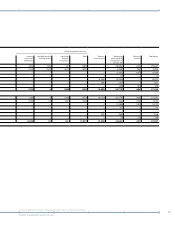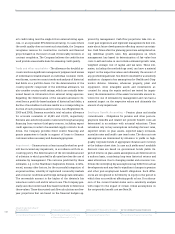Siemens 2009 Annual Report Download - page 220
Download and view the complete annual report
Please find page 220 of the 2009 Siemens annual report below. You can navigate through the pages in the report by either clicking on the pages listed below, or by using the keyword search tool below to find specific information within the annual report.
Reports Supervisory Board /
Managing Board Corporate Governance Management’s discussion and analysis Consolidated Financial Statements
Consolidated Statements of Income Consolidated Statements of Income
and Expense Recognized in Equity
Consolidated Balance Sheets Consolidated Statements of Cash Flow
are stated at cost less accumulated amortization and impair-
ment losses with an amortization period of generally three to
five years.
Earnings per share – Basic earnings per share is computed by
dividing income from continuing operations, income from dis-
continued operations and net income, all attributable to ordi-
nary shareholders of Siemens AG by the weighted average
number of shares outstanding during the year. Diluted earn-
ings per share are calculated by assuming conversion or exer-
cise of all potentially dilutive securities and share-based pay-
ment plans.
Goodwill – Goodwill is not amortized, but instead tested for
impairment annually, as well as whenever there are events or
changes in circumstances (“triggering events”) which suggest
that the carrying amount may not be recoverable. Goodwill is
carried at cost less accumulated impairment losses.
The goodwill impairment test is performed at the level of divi-
sions which represent cash-generating units or groups of
cash-generating units and are the lowest level at which good-
will is monitored for internal management purposes.
For the purpose of impairment testing, goodwill acquired in a
business combination is allocated to the (groups of) cash-gen-
erating unit(s) that are expected to benefit from the synergies
of the business combination. If the carrying amount of the di-
vision, to which the goodwill is allocated, exceeds its recover-
able amount goodwill allocated to this division is reduced ac-
cordingly. The recoverable amount is the higher of the divi-
sion’s fair value less costs to sell and its value in use. Siemens
generally determines the recoverable amount of a Division
based on its fair value less costs to sell. These values are gener-
ally determined based on discounted cash flow calculations.
Impairment losses on goodwill are not reversed in future peri-
ods if the recoverable amount exceeds the carrying amount of
the (group of) cash-generating unit(s) to which the goodwill is
allocated.
values are sales prices for the component when it is regularly
sold on a stand-alone basis, third-party prices for similar com-
ponents or – under certain circumstances – cost plus, an ade-
quate business-specific profit margin related to the relevant
element. If the three criteria are not met, revenue is deferred
until such criteria are met or until the period in which the last
undelivered element is delivered. The amount allocable to the
delivered elements is limited to the amount that is not contin-
gent upon delivery of additional elements or meeting other
specified performance conditions.
Product-related expenses and losses from onerous con-
tracts – Provisions for estimated costs related to product war-
ranties are recorded in Cost of goods sold and services ren-
dered at the time the related sale is recognized, and are estab-
lished on an individual basis, except for the standard product
business. The estimates reflect historic trends of warranty
costs, as well as information regarding product failure experi-
enced during construction, installation or testing of products.
In the case of new products, expert opinions and industry data
are also taken into consideration in estimating product war-
ranty provisions. Expected losses from onerous contracts are
recognized in the period when the current estimate of total
contract costs exceeds contract revenue.
Research and development costs – Costs of research activi-
ties undertaken with the prospect of gaining new scientific or
technical knowledge and understanding are expensed as in-
curred.
Costs for development activities, whereby research findings
are applied to a plan or design for the production of new or
substantially improved products and processes, are capitalized
if development costs can be measured reliably, the product or
process is technically and commercially feasible, future eco-
nomic benefits are probable and Siemens intends, and has
sufficient resources, to complete development and to use or
sell the asset. The costs capitalized include the cost of materi-
als, direct labour and other directly attributable expenditure
that serves to prepare the asset for use. Such capitalized costs
are included in Other intangible assets as other internally gen-
erated intangible assets (see Note 17). Other development
costs are expensed as incurred. Capitalized development costs
























